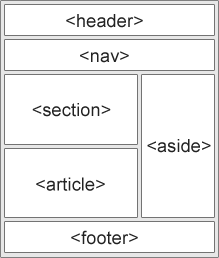HTML Layout Elements
Websites often display content in multiple columns (like a magazine or newspaper).HTML5 offers new semantic elements that define the different parts of a web page:

|
|
HTML Layout Techniques
There are four different ways to create multicolumn layouts. Each way has its pros and cons:- HTML tables
- CSS float property
- CSS framework
- CSS flexbox
Which One to Choose?
HTML Tables
The <table> element was not designed to be a layout tool! The purpose of the <table> element is to display tabular data. So, do not use tables for your page layout! They will bring a mess into your code. And imagine how hard it will be to redesign your site after a couple of months.
Tip: Do NOT use tables for your page layout!
CSS Frameworks
If you want to create your layout fast, you can use a framework, like W3.CSS or Bootstrap.CSS Floats
It is common to do entire web layouts using the CSS float property. Float is easy to learn - you just need to remember how the float and clear properties work. Disadvantages: Floating elements are tied to the document flow, which may harm the flexibility. Learn more about float in our CSS Float and Clear chapter.CSS Flexbox
Flexbox is a new layout mode in CSS3.Use of flexbox ensures that elements behave predictably when the page layout must accommodate different screen sizes and different display devices. Disadvantages: Does not work in IE10 and earlier.
Learn more about flexbox in our CSS Flexbox chapter.
No comments:
Post a Comment